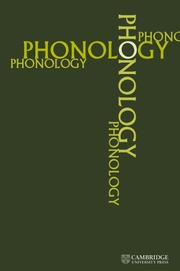In a recent article in Phonology (Hyman Reference Hyman2011), I provided evidence that Gokana, a Cross-River Niger-Congo language of Nigeria, cares very little, if at all, about organising its consonants and vowels into syllables. The only potential argument in favour of the syllable that was presented concerned the structure of the prosodic stem, which consists of a root and at most one derivational and one inflectional suffix. While the prosodic stem can have up to four moras and any of the shapes in (1a), the shapes in (1b) are unattested.
-
(1)

The possible syllable-based explanation that was offered was that the prosodic stem consists of a single trochee with up to two bimoraic syllables, as in (2).
-
(2)

By this account the shapes in (1b) are ruled out by the common constraint that a syllable can be restricted to at most two moras. If the syllabic structures in (2) were not recognised, one would have to stipulate that quadrimoraic *CVCVVV and *CVVVCV are disallowed, while CVVVV and CVVCVV are well-formed. This was (and remains) the only evidence that Gokana phonology unambiguously refers to the syllable. Or does it?Footnote 1
The question is how else one might ‘explain’ why *CVCVVV and *CVVVCV are unattested as possible prosodic stem shapes.Footnote 2 Since the appearance of Hyman (Reference Hyman2011), I have realised that there is another possible account for the absence of these forms. Recall that the prosodic stem consists of an obligatory root and at most one derivational and one inflectional suffix. The class of such suffixes is, however, quite limited in the language. In (3) I repeat the structure of the prosodic stem from Hyman (Reference Hyman2011: 70).Footnote 3
-
(3)

As seen, derivational suffixes can have the shape -V or -CV, while inflectional suffixes have the shape -VV. Since simple roots have the shape CV, CVV or CVC, there are six possible input shapes for root + derivational suffix + inflectional suffix sequences.Footnote 4 However, as seen in (4), none of these six combinations can produce *CVCVVV or *CVVVCV.
-
(4)

In the above examples the logophoric suffix /-ÈÈ/ undergoes a rule that shortens a long vowel which occurs after another vowel, i.e. VV→V / V_ (Hyman Reference Hyman2011: 65).Footnote 5 The last example also shows consonant-cluster simplification before the instrumental suffix /-ma/. In addition to simplex roots, there are complex roots of the shape CVCV or CVVCV, whose final V or CV is often identifiable as a frozen derivational suffix. When one of the derivational suffixes in (4) is added, it replaces the final V and sometimes the second root consonant (since a prosodic stem cannot have a third C). As a result, these also cannot produce *CVCVVV. The examples in (5) are repeated from Hyman (Reference Hyman2011: 70).
-
(5)

The significance of the above is that we now have two different potential explanations for why Gokana prosodic stems cannot have the shape *CVCVVV or *CVVVCV: (i) the syllabic trochee account of Hyman (Reference Hyman2011), which allows CVV.CVV and CVV.VV, but not the trimoraic syllables of *CVVV.CV and *CV.CVVV; and (ii) the absence of a morphological input that could produce *CVCVVV or *CVVVCV. In (6) I provide inputs that could in principle give rise to these sequences, but don't (for the reasons indicated).Footnote 6
-
(6)

While the first explanation proposes a principled reason for the lack of these sequences, the second views their absence as an historical accident. Of course, since the morphology has been reduced from the original pre-Gokana situation, which undoubtedly was much richer, one could always argue that the diachronic morphological reduction was (partly) driven by the end goal of placing a maximal bisyllabic CVV.(C)VV condition on the prosodic stem. But to make this argument non-circular, we would have to say that Gokana introduced the V-shortening rule to make sure that an input such as CVC+V+VV did not come out as *CVCVVV.Footnote 7 However, this cannot be the reason why there is a vowel-shortening rule, since the rule applies even when not needed, e.g. after CV roots: /tú-è/ ‘take (log)’. The first analysis would be much more convincing if vowel shortening took place only when it was needed to fit the string into the maximal CVV.(C)VV trochaic foot.Footnote 8 Given this, it seems that the second hypothesis has to be taken seriously: there is no CVCVVV or CVVVCV because no input can produce such an output. If correct, the syllabic trochee analysis may still be descriptively compatible with the data, but not necessarily explanatory of why the facts are the way they are. Gokana can thus still be considered to be a language which may not refer to the syllable at all.







